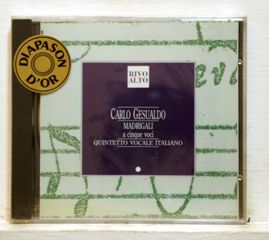Gesualdo da Venosa - Madrigali a 5 Voci Libro III (2012)
Gesualdo da Venosa - Madrigali a 5 Voci Libro III (2012)

[1] Voi volete ch'io mora [2] Ahi, disperata vita [3] Languisco e moro [4] Del bel de' bei vostri occhi [5] Ahi, dispietata e cruda [6] Dolce spirito d'Amore [7] Sospirava il mio core [8] Veggio, si, dal mio sole [9] Non t'amo, o voce ingrata [10] Meraviglia d'Amore! [11] Crudelissima doglia! [12] Se piange, ohime [13] Ancidetemi pur [14] Se vi miro pietosa [15] Deh, se gia fu crudele [16] Dolcissimo sospiro [17] Donna, se m'ancidete Quintetto Vocale Italiano: Karla Schlean - soprano Clara Foti - mezzo-soprano Elena Mazzoni - contralto Rodolfo Farolfi - tenor Gastone Sarti - baritone Dmitri Nabokov - bass Angelo Ephrikian - director
It is in Gesualdo's third book of madrigals that his notorious musical characteristics begin to appear definitively. Book 3 was published in 1595, only a year before Book 4; both were likely written while the composer was at Ferrara between 1594 - 1596. Many commentators like to draw a connection between the emerging restlessness in Gesualdo's musical style and the murder he committed a few years earlier. But, while it's impossible to consider the man and the music as totally separate, to overemphasize biography in discussing his work is spurious, simply because there were parallel and similar developments in the world of the Ferrarese musical elite. He did not come to his stylistic ideas alone; other composers with whom he had contact were moving in the same direction. The difference, as has been said, between Gesualdo and his contemporaries, as well as between the late and early works, is more of degree than of substance.
Several features emerge in fuller bloom in Book 3 than ever before; by this time Gesualdo is unambiguously composing for the throats and ears of the elite only. His use of imitation becomes considerably more flexible, even when using difficult double, or triple counterpoint. His melodic lines in general begin to become more harmonically forceful in their implications. It becomes fairly common for him to outline sevenths and ninths, intervals that are almost impossible for amateurs to handle skillfully. Of course, the harmonic language begins to expand as well. Diminished and augmented intervals become more common, as well as strange chord formations set in surprising harmonic rhythms. Gesualdo's extremely effective, idiosyncratic use of pedal points against parallel motion also emerges in Book 3. This will have much to do with how he handles cadences in the later, more difficult works.
The occasional capriciousness of these works is notable. In the interest of the creating more expressive melodic, contrapuntal motion Gesualdo seems at time almost indifferent to the unwieldy harmonic results. This is what leads one to believe that the harmonic style of the later works, which self-consciously use dissonance in a way that the works in Book 3 do not, was stumbled across in the course of his melodic yearning -- a happy dissonant accident.
Through all the new developments in Book 3, Gesualdo is nevertheless always in total control of the tonality of the piece on the larger scale. He usually, and always convincingly, begins and ends the pieces in the same key, no matter how far he's wandered from the normal territory of that key in the meantime. The miraculous concluding cadences, that work against all odds, lead to an impression at times that we're actually present with Gesualdo's mind, hearing it process a mass of terribly complex, diffuse information. But that mind is a hell of an engine; it spits it all back out in a neat little package, wrapped, ready to go. ---Donato Mancini, Rovi
download (mp3 @320 kbs):
uploaded yandex 4shared mega mediafire solidfiles zalivalka cloudmailru oboom








